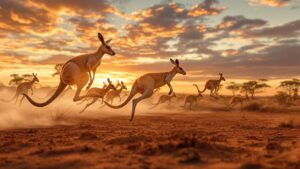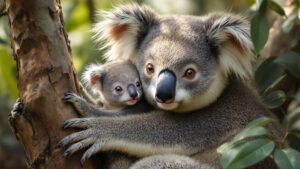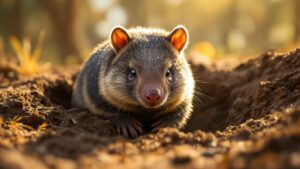Marsupials: Nature’s Pouch-Bearing Marvels of the Southern Hemisphere
When most people hear the word “marsupial,” the image that jumps to mind is the iconic kangaroo bounding across the Australian outback. But this fascinating group of mammals is far more diverse and widespread than many realize. Marsupials represent one of the most extraordinary branches on the mammalian tree, known for their unique method of reproduction and for nurturing their young in specialized pouches. From tree-dwelling gliders to burrowing wombats and the enigmatic marsupial “wolves” of Tasmania’s past, marsupials showcase an astonishing range of behaviors, adaptations, and ecological roles. What makes marsupials particularly compelling is not just their distinctiveness, but their evolutionary journey and ecological importance. They dominate entire ecosystems in Australia and have intriguing representatives in the Americas. Understanding marsupials offers a glimpse into alternative evolutionary solutions to survival, growth, and parental care—solutions that are just as effective as those developed by their placental mammal cousins.

Kangaroos
Kangaroos: The Hopping Heartbeat of Australia’s Wildlands Across the red-dusted plains, through eucalyptus forests and grassy bushlands, a rhythmic, ground-shaking beat echoes across the horizon—it’s the sound of kangaroos bounding across their homeland. Instantly recognizable and deeply emblematic of Australia, kangaroos are more than just a symbol. They are evolutionary marvels, ecosystem engineers, and fascinating social mammals whose unique biology continues to captivate scientists and nature lovers alike. With their

Koala
Koala: The Sleepy Climber of Australia’s Eucalyptus Forests Few animals inspire the same instant affection as the koala. With their fluffy ears, large noses, and sleepy expressions, koalas have become international icons of Australia’s wildlife. Despite their cuddly appearance, these marsupials are highly specialized animals, adapted to a very specific lifestyle in the treetops of eucalyptus forests. Scientifically known as Phascolarctos cinereus, the koala is a solitary, tree-dwelling mammal that

Possums
Possums: The Nocturnal Navigators of Forest Canopies and Backyard Shadows As dusk falls over forests, gardens, and suburban rooftops, a new cast of creatures silently takes the stage. Among the most agile and adaptable are the possums—furry, wide-eyed marsupials that glide, climb, and scamper under cover of darkness. Known for their tree-dwelling agility and omnivorous curiosity, possums occupy a fascinating niche across Australia, New Guinea, and nearby islands. These animals

Wombats
Wombats: The Burrowing Builders of Australia’s Wild Heart Deep in the scrublands, eucalyptus forests, and rugged mountain valleys of Australia, a low-slung, sturdy creature waddles through the underbrush, nose to the ground and fur dusted with soil. With their compact bodies, powerful claws, and endearing expressions, wombats are among the most fascinating and underappreciated marsupials in the animal kingdom. They may not possess the fame of kangaroos or koalas, but
Biological Uniqueness: What Defines a Marsupial
Marsupials belong to the infraclass Metatheria and are most easily distinguished from placental mammals (Eutheria) by their reproductive system. Female marsupials give birth to underdeveloped young after a very short gestation period. These tiny newborns, often no bigger than a jellybean, must crawl unassisted into their mother’s pouch, where they latch onto a teat and continue developing for weeks or months. This remarkable process offers certain advantages. The pouch-based rearing system allows for rapid reproduction, as females can support multiple stages of development simultaneously—an embryo in the uterus, a pouch-bound joey, and a young joey that has left the pouch but still nurses. Many marsupials also possess bifurcated reproductive systems, with two uteri and two vaginas, further enhancing reproductive flexibility. Marsupials are primarily found in Australasia, including Australia, New Guinea, and surrounding islands, with several species native to the Americas, especially Central and South America. Despite their geographic limitation, their adaptive radiation is impressive, producing a diversity of forms comparable to placental mammals.
Macropods: The Bounding Grazers of Australia
The most famous marsupial group is the macropods, which includes kangaroos, wallabies, wallaroos, and tree kangaroos. The name macropod means “big foot,” and indeed, these animals are known for their powerful hind legs and large feet adapted for hopping—a highly energy-efficient mode of travel over long distances. Kangaroos are among the most iconic Australian animals. Red kangaroos, the largest marsupials, can grow taller than an adult human and cover over 25 feet in a single bound. They graze on grasses and are vital to maintaining the structure and health of arid grassland ecosystems. Wallabies, their smaller cousins, occupy denser vegetation and forested areas. Tree kangaroos, astonishingly agile for their size, have adapted to life in the treetops of tropical rainforests in northern Australia and New Guinea. Macropods have highly developed social structures, efficient digestive systems for low-nutrient plant diets, and strong tails used for balance and propulsion. They play essential roles in shaping vegetation and dispersing seeds.
Dasyurids: The Carnivorous Predators of the Marsupial World
Marsupials are not all herbivores. The dasyurids form a family of mostly carnivorous marsupials, including quolls, dunnarts, and the famed Tasmanian devil. These animals fill ecological niches similar to those of weasels, foxes, and other small to medium-sized placental predators. Tasmanian devils are the largest surviving carnivorous marsupials. Found only in Tasmania, they have powerful jaws capable of crushing bone and are opportunistic scavengers and hunters. Their intense vocalizations and communal feeding behavior have made them cultural icons. Quolls, spotted and secretive, are agile predators of birds, reptiles, and insects. Dunnarts and planigales, small insectivorous marsupials, hunt at night and reproduce prolifically to adapt to their short lifespans and predation pressures. Historically, the dasyurids included the extinct thylacine or Tasmanian tiger, a wolf-like marsupial predator that once roamed Tasmania and mainland Australia. Its extinction in the 20th century is a sobering reminder of the fragility of marsupial populations under environmental and human pressures.
Diprotodonts: The Browsers, Climbers, and Burrowers
The order Diprotodontia contains the largest number of marsupial species and spans a wide variety of lifestyles. This group includes koalas, wombats, possums, and gliders. What unites them is their distinctive dental structure—a pair of large, forward-facing incisors in the lower jaw. Koalas are specialized folivores, eating mostly eucalyptus leaves, which are toxic to most animals. Their slow metabolism and sedentary nature are adaptations to this low-energy diet. Despite their cuddly appearance, koalas are territorial and vocal, especially during mating season. Wombats are burrowing herbivores with powerful claws and a unique backwards-facing pouch that prevents soil from entering while digging. They create extensive tunnel networks and have cube-shaped feces, an adaptation believed to prevent rolling and aid in territorial marking. Possums and gliders are mostly nocturnal and arboreal, with gliders such as the sugar glider and greater glider using skin membranes to glide between trees. These animals play key roles in pollination, seed dispersal, and insect control in forest ecosystems.
Marsupial Moles and Bandicoots: The Underground and Opportunistic
Australia’s deserts and dry scrublands are home to some of the most unusual marsupials, including the marsupial moles and bandicoots. These creatures have adapted to life underground and in challenging climates. Marsupial moles are blind, earless, and have shovel-like forelimbs that allow them to swim through sand in a way reminiscent of their placental mole counterparts. They are incredibly elusive and poorly understood but believed to feed on invertebrates below the surface. Bandicoots and bilbies are omnivorous marsupials with long snouts and sharp claws used for digging. Bilbies, in particular, have large ears for thermoregulation and keen hearing. These species have suffered from introduced predators and habitat loss but are subjects of focused conservation efforts.
American Marsupials: The Northern Outliers
While Australia is the heartland of marsupial diversity, the Americas are home to fascinating marsupial species as well. The most notable is the Virginia opossum, the only marsupial native to the United States and Canada. Opossums are scavengers and opportunistic omnivores, feeding on everything from fruit and insects to small animals and carrion. They are known for “playing dead” as a defense mechanism and have prehensile tails and opposable thumbs on their hind feet for climbing. In Central and South America, other opossum species inhabit tropical forests, often nesting in tree hollows and feeding on a diverse diet of fruit, insects, and small vertebrates. Their ecological role includes pest control and seed dispersion.
Marsupials and Ecosystem Dynamics
Marsupials fulfill critical ecological functions in their respective habitats. Herbivorous marsupials manage vegetation, maintain grassland and forest health, and disperse seeds through their droppings. Carnivorous and insectivorous species help regulate prey populations and support food webs. Many marsupials also serve as ecosystem engineers. Burrowing species like wombats alter soil composition and create habitats used by other animals. Arboreal marsupials such as gliders and possums interact with plant pollination and canopy structure, while macropods influence grazing patterns and bushfire cycles. Marsupials are often prey themselves, forming key links in the diet of raptors, snakes, and introduced predators like foxes and cats. Their population levels can signal environmental health, and their behaviors provide insight into ecological balance.
Threats and Conservation Efforts
Marsupials face significant threats from habitat destruction, climate change, disease, and invasive species. Urbanization, agriculture, and logging have fragmented habitats and reduced the availability of critical resources. Invasive predators, especially cats and foxes, have devastated populations of smaller marsupials. Conservation efforts focus on habitat protection, captive breeding programs, predator control, and public education. Sanctuaries and wildlife corridors have been established to support reintroduction and long-term survival. Species like the eastern quoll and the greater bilby have become flagship species for conservation in Australia. Research into marsupial genetics and biology is also helping scientists understand resilience, adaptability, and disease resistance. The study of marsupial milk, for instance, has yielded insights into immunology and neonatal development.
Cultural and Scientific Significance
Marsupials hold a special place in the cultural heritage of Indigenous Australians and are featured in stories, art, and traditional knowledge systems. They are also beloved symbols in modern Australian identity, appearing in mascots, media, and tourism campaigns. Scientifically, marsupials are important for understanding mammalian evolution. Their reproductive strategy provides a contrast to placental mammals, offering comparative models for studying development, endocrinology, and ecology. Their fossils help reconstruct ancient ecosystems and migration patterns, while their ongoing survival tells a story of adaptation in extreme and isolated environments.
A Journey Through the Pouch
Marsupials are more than Australia’s most charismatic creatures—they are evolutionary marvels with a stunning array of adaptations and ecological roles. From the bounding red kangaroo to the gliding sugar glider and the elusive marsupial mole, these animals reflect nature’s creativity and complexity. Understanding marsupials invites us to rethink assumptions about what mammals are and how life can flourish in parallel evolutionary tracks. Their stories are woven into the landscapes they inhabit and the cultural narratives they inspire. Whether you’re drawn to their biology, their charm, or their conservation, marsupials offer a world of wonder waiting to be explored. Dive into the diverse subcategories of these pouch-bearing mammals and discover how evolution, ecology, and resilience converge in the marsupial realm.

